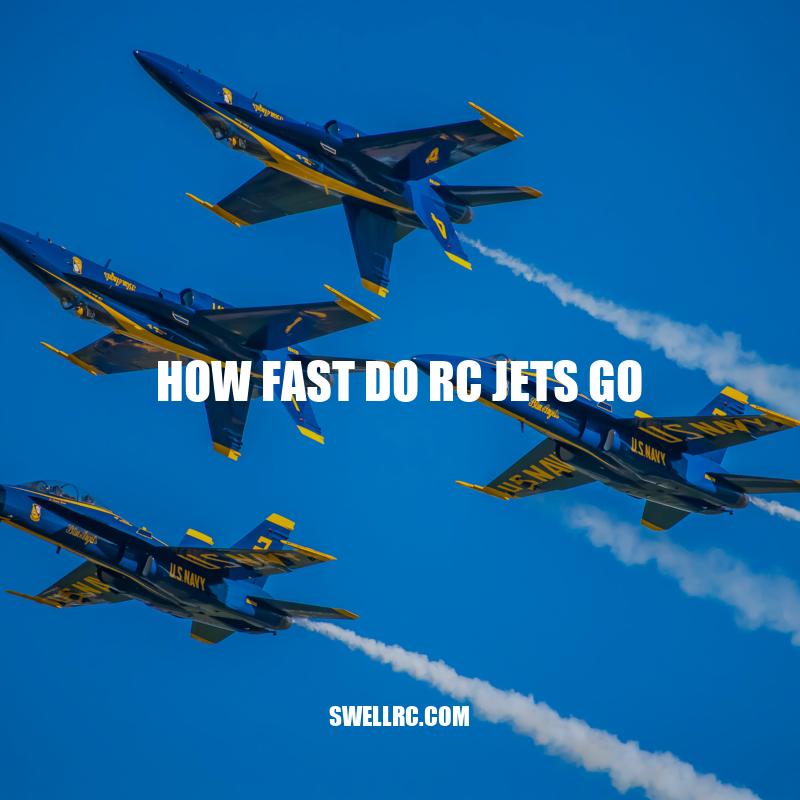RC Jet Speed: Factors and Maximum Velocity
Remote-controlled jets or RC jets have become one of the most popular hobbies around the world today. While the first RC planes were slow and relatively simple, RC jet technology has grown significantly, leading to many advanced models with high-performance engines that rival those of real commercial jets. Most people are drawn to RC jets because of the excitement and thrill that comes with flying these miniature aircrafts. However, many people are left wondering, how fast do RC jets go? The answer isn’t straightforward, as there are many factors that contribute to the maximum speeds that these miniature jets can attain. In this article, we will delve deeper into the factors that affect the speed of RC jets, and how fast they can go. We will also discuss the implications of high speeds, the growing popularity of RC jet racing, and the importance of safety and responsible flying practices.
Factors that Affect RC Jet Speed
The maximum speed of RC jets can differ based on various factors such as:
- Weight and aerodynamics of the jet
- Engine power and type of fuel used
- Weather and wind conditions
- Skill level of the pilot and how they control the jet
To understand how speed is impacted by these factors, let’s discuss each one in more detail:
Weight and Aerodynamics of the Jet
The weight and aerodynamics of the RC jet can have a significant impact on the speed. A lighter and more streamlined jet will generally have a higher top speed than a heavier or bulkier one. The aerodynamics of the jet relate to how it is designed and constructed, including the wing shape, airfoil, and other factors.
Engine Power and Fuel Type
The engine is one of the most important factors that determine the maximum speed of an RC jet. The power of the engine depends on the type of fuel used, the engine capacity, and design. Turbine-powered engines generally produce more power and have a higher top speed than gas or electric engines.
Weather and Wind Conditions
Weather and wind conditions can significantly impact the speed of RC jets. Strong winds and storms can affect the aerodynamics of the jet and make it difficult to maintain stability and control. On the other hand, clear and calm weather conditions with no wind can provide an ideal environment for RC jet flying.
Skill Level of the Pilot
The experience and skill level of the pilot can also play an important role in the speed of RC jets. An experienced pilot with advanced skills can handle the jet better and push it to its limits for the highest possible speed. In contrast, a beginner may struggle with controlling the jet or pushing it too far, which can impact the speed.
How fast can an RC jet go?
RC jets can fly at impressive speeds, with some reaching velocities of up to 200 mph. However, the exact speed of an RC jet will depend on factors such as its size, power source, and aerodynamics.
Some of the fastest RC jets available on the market include the:
- Freewing L-39 Albatros – capable of speeds up to 98 mph
- BlitzRCWorks Super B-25 Mitchell – capable of speeds up to 150 mph
- Benchmark RC Yak-130 – capable of speeds up to 150 mph
- Q-Jet F-22 Raptor – capable of speeds up to 200 mph
It’s important to note that flying an RC jet at these high speeds requires skill and experience, as well as adherence to safety guidelines. Consult the manufacturer’s instructions and safety guidelines before operating any RC jet.
Maximum Speeds of Different RC Jets
The speed of an RC jet can vary significantly based on its type, engine power, and other factors. Here are some examples of RC jets and the top speeds they can achieve:
| RC Jet Type | Top Speed |
|---|---|
| Electric-powered RC Jets | 50-80mph |
| Gas-powered RC Jets | 90-150mph |
| Turbine-powered RC Jets | 200mph or more |
Gas-Powered RC Jets
Gas-powered RC jets are one of the most common types of RC jets. These jets are powered by a two-stroke engine that uses a gasoline-oil mixture for fuel. Some interesting facts about gas-powered RC jets include:
– These jets can accelerate from 0 to 60 mph in just a few seconds
– The engines of these jets can reach speeds of up to 40,000 RPM
– They create a significant amount of noise and can be heard from a distance
Turbine-Powered RC Jets
Turbine-powered RC jets are the fastest and most powerful type of RC jets. These jets use a gas turbine engine that compresses and heats air to create thrust. Some interesting facts about turbine-powered RC jets include:
– They can reach takeoff speeds of up to 200 mph in just a few seconds
– These jets can generate up to 90 pounds of thrust
– They produce a distinct high-pitched whine, which is different from the noise created by gas-powered RC jets.
RC jet enthusiasts can find many online resources that offer information on various types of RC jets, reviews, and product comparisons. Online forums and communities can also provide helpful tips and support for those interested in RC jet flying.
How fast is the fastest RC jet?
The fastest radio-controlled (RC) jet in the world is the X-43, which holds the world speed record for an unmanned aircraft at a whopping 7,310 kilometers per hour (4,520 miles per hour). This is more than six times the speed of sound!
Some other notable RC jets that are also incredibly fast include:
- The Avonds F-15 Eagle, which can reach speeds of up to 370 kilometers per hour (230 miles per hour)
- The Freewing Mirage 2000, which can reach speeds of up to 190 kilometers per hour (118 miles per hour)
- The Extreme Flight RC 104″ Extra, which can reach speeds of up to 250 kilometers per hour (155 miles per hour)
For those interested in purchasing an RC jet or learning more about the hobby, websites such as Horizon Hobby and Hobbyking offer a wide variety of models and resources.
Implications of High Speeds
While flying an RC jet at high speeds can be thrilling and exciting, it can also be dangerous. Here are some things to keep in mind:
– High speeds can create a lot of turbulence and instability, which can cause the jet to become difficult to control, especially for less-experienced pilots.
– Flying an RC jet in a crowded area or too close to people can produce potentially hazardous situations, and even damage or injure property.
– Some locations have specific regulations for flying RC jets or require special permits, so it’s important to be aware of these rules and follow them to stay safe and legal.
There are many ways to mitigate risks when flying an RC jet, including:
– Practicing safe flying habits and maintaining a safe distance from people and property
– Using advanced safety features such as altitude limiters to prevent the jet from flying too high
– Joining a local RC flying club or team to learn from experienced pilots and gain knowledge about flying techniques and best practices.
RC jet pilots should always prioritize safety, and abide by the regulations set by governing bodies such as the Academy of Model Aeronautics (AMA) when flying. The AMA website offers helpful resources, training programs, and safety guidelines for RC pilots.
Can you fly a jet for fun?
Yes, it is possible to fly a jet for fun. Here are some ways to make it happen:
- Join a flight simulator club or center. They offer realistic experiences in a safe environment.
- Sign up for a jet fighter experience with a company such as Top Gun Experience or Air Combat USA.
- Consider private jet rentals or charters. Some companies even offer “demo flights” for those interested in purchasing their own jet.
However, keep in mind that flying a jet requires proper training and certification. It is not something to be taken lightly, and safety should always be a top priority.
RC Jet Racing
RC jet racing is a thrilling and fast-paced sport that has grown in popularity in recent years. Here’s what you need to know:
– RC jet races take place on a closed course, with multiple competitors racing their jets around a set number of laps in the fastest time possible.
– Races can take place indoors or outdoors, with pilots using high-speed jets that can exceed 200 mph.
– Competitors are typically divided into different classes based on the type of jet, engine size, and other factors.
– Spectators can enjoy the excitement of the race and watch pilots maneuver the jets through turns and down straightaways at dizzying speeds.
There are many organizations and clubs dedicated to RC jet racing, such as the International Miniature Aerobatic Club (IMAC), which hosts competitions and events around the world. Other resources for those interested in RC jet racing include:
– Online forums and communities where pilots can connect with other enthusiasts and share tips and tricks for improving their performance.
– RC jet racing publications and websites that cover the latest news and developments in the sport.
– Racing equipment and gear such as radio controllers designed specifically for racing.
RC jet racing offers an exciting and rewarding way to enjoy the exhilaration of flying high-speed jets, and with the right equipment and training, anyone can participate in this fast-paced sport.
How much does a modified race car cost?
The cost of a modified race car can vary greatly depending on many factors such as the type of racing, the modifications made, the brand and the condition of the car. Generally, modified race cars can range anywhere from $5,000 to over $100,000.
Here are some factors that can affect the cost:
- The type of racing: drag racing, dirt track racing, and NASCAR all have different requirements and costs.
- The modifications made: performance upgrades, roll cages, and other safety measures can add to the cost.
- The brand: some brands may have a higher cost due to their reputation or popularity.
- The condition of the car: used race cars can be cheaper, but may require more maintenance and repairs.
If you are interested in purchasing a modified race car, some websites and products that may be helpful include:
Conclusion
In conclusion, the question of how fast do RC jets go is not simple to answer, as there are a variety of factors that can impact the speed of an RC jet. However, with the right jet, engine, fuel, and other factors taken into account, high-end RC jets can reach speeds of more than 200 mph. As with any high-speed sport or activity, safety is of the utmost importance, and pilots must take proper precautions to ensure the safety of themselves and others when flying RC jets.
For those looking to get involved in RC jet flying or racing, there are numerous resources available online and offline, including clubs, publications, and websites dedicated to the hobby. With dedication, practice, and a passion for the sport, fly enthusiasts can experience the thrill of high-speed flight in a safe and fun way through RC jets.



